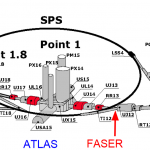In early 2016, one of the greatest scientific news around the world was the experimental discovery of a new particle by A.J. Krasznahorkay and his group at MTA Atomki, Debrecen: Amerikai fizikusok szerint eddig ismeretlen erőt találtak az MTA Atomkiban.
The particle was named X(17), its mass was measured to be 34 times the electron mass and it was very soon associated with the dark matter of our Universe, thus contributing to resolve one of the greatest mystery in contemporary physics, the presently unknown composition of the dark matter: Has a Hungarian physics lab found a fifth force of nature?
Theoretical studies predict several particles with very similar properties to X(17), thus motivated a new research program at CERN. In order to perform the experiments, a new detector system has to be developed, named FASER (Forward Search Experiment). In contrast to the present large-scale equipments, which are designed to detect heavy particles (e.g Higgs boson), this new system will capable of detecting particles with much smaller masses, like the mass of X(17), which is 7000 times smaller than the mass of the Higgs particle.
The development of the FASER detector system has been started, the first data collection is planned to be in the period of 2021-23 according to the announcement on CERN's news portal: FASER: CERN approves new experiment to look for long-lived, exotic particles.
The goals of the experiments have already been published referring also to the results of Debrecen: Axionlike particles at FASER: The LHC as a photon beam dump.
 Magyar
Magyar

